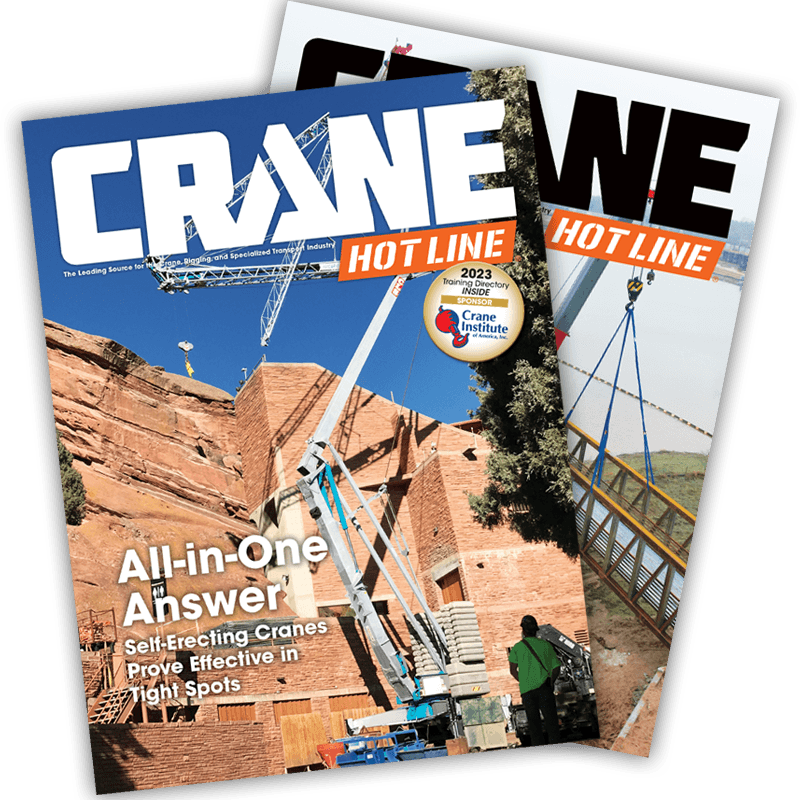Is Cal/OSHA Qualified to Classify Cranes?
Lucy Perry
October 4, 2006 • They say new trends are born on the West Coast while the rest of the country rides the wave. But the battle brewing on self-erecting cranes in

The issue at hand is that
DOSH openly admits to having no engineering to support their stand but says they aren't required to have it. Even under the belief that it is acting on the behalf of both the construction industry and its state's citizens, is it a state Occupational Safety and Health department's job to classify cranes?
Watching the issue unfold is crane industry safety consultant Brad Closson, who succinctly puts it this way: “The core issue of all of this is the question as to whether the division has the right to reclassify any crane based upon its perception of the crane's design.” He goes on to say DOSH has reclassified the crane from the manufacturer's designation of a B30.5 mobile crane, in accordance with ss4884 of the California Code of Regulations, to a B30.3 tower crane.

Between a rock and a hard place
At a recent meeting of DOSH and petitioning crane rental companies, which DOSH Principal Safety Engineer Larry McCune termed “a good discussion,” DOSH agreed to modify its tower crane permit regulations to allow crane owners to hold annual permits for mobile, self-contained, self-erecting tower cranes with a capacity of 3 tons or less. The owner would have to identify the operator and notify DOSH when relocating the crane.
The reality of it is crane owners may not take the time out of their schedules to notify DOSH several times a day as they move their self-erecting cranes both within a single jobsite and from jobsite to jobsite, as it is designed to do.
When asked what DOSH believes is the difference between an annual permit and a notification of relocation, Closson said: “I do not have a clue. Their allowing the annual permit was an effort to quiet the petitioners. This permit is of questionable value and is ill-defined for implementation.”
Fred Walter, an attorney for the petitioning crane rental companies, was quoted in an issue of the Cal/OSHA Reporter as saying that though DOSH does agree that it's not necessary to have CCO-certified staffers to set self-erectors up and take them down the group didn't really give them anything because staffers still have to be certified to operate the cranes. “In other words, we can put them up and take them down,” Walter said, “We just can't use them.”
To add insult to injury, there aren't that many CCO-certified tower crane operators in
In the article, Walter also disputes the assertion that self-erectors cannot be operated safely by non-CCO operators trained by the manufacturer or its representatives. “Those opposed to our position chose not to hear Brad Closson's and Grove Crane safety manager Eric Fidler's explanations that these cranes are designed so differently from traditional tower cranes that to operate as if they are tower cranes is more unsafe than putting someone with specific training at the controls,” he is quoted as saying in the article.
As a result of the dispute, Closson has petitioned the Standards Board to remove ss4884 in its entirety because it is not being enforced and establishes a false sense of security in the users who believe the cranes meet a certain engineering specification level in order to operate in
“I do not want this, but having unqualified people reclassify cranes to criteria the cranes do not meet simply because they can drastically lowers safety and scares me,” Closson said. His request has been before DOSH since July; he's yet to receive a hearing date.

Will new technology fall in line?
As crane engineering becomes more advanced and hybrid machines, such as the Grove GTK 1100, become less of an anomaly, products like this yet-to-be classified machine have the potential to present their own set of challenges in
Engineered with the Manitowoc lattice boom's quick assembly qualities, the Grove mobile crane's telescoping boom capabilities, the Potain tower crane's self-assembly and erection features, the GTK crane consists of a six-section telescopic mast topped with a telescopic luffing boom and four spreaders attached to outriggers. At first glance Closson wondered whether Grove will designate these devices as B30.5 (Mobile Cranes) or B30.3 (Construction Tower Cranes). Because the tower is vertical, he says it could fall into the California Labor codes' definition of a “mobile tower crane,” in which case, only CCO-certified operators could run it.
But Grove is quick to say it's a non-issue so far, and they don't see the dispute as having much impact on how they classify the crane. “That's an issue for us with the self-erecting cranes, because we're marketing them rightfully against boom trucks, truck cranes, and telehandlers, where one guy can go out and work with the product,” said one company official.
He believed labeling self-erectors as tower cranes and requiring two workers is “an efficiency hardship” and pointed out the GTK is a big crane that will require a crew to assemble and operate. “They're much more in line with a true Grove GMK mobile crane or a
The


